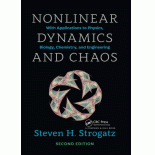
Concept explainers
Interpretation:
To verify the following statements:Function g(x) near the origin is roughly parabolic.
The function g(x) has infinitely many wiggles as x ranges over the real line.
Concept Introduction:
Renormalization is based on the self-similarity of the Figtree. The twigs look like the earlier branches, except they are scaled down in both x and r directions. The Figtree structure shows an endless repetition of the same dynamical processes, a
Self-similarity is mathematically expressed as comparing
The function
The functional equation for
Here,
g(x) is the renormalized function of f(x) with renormalization parameter
As, at the onset of chaos, it isn’t required to shift R to renormalize, the above equation can be written as
Hence
This function g(x) is often written in terms of the power series solution:
Want to see the full answer?
Check out a sample textbook solution
Chapter 10 Solutions
Nonlinear Dynamics and Chaos
- Determine if the statemment is true or false. If the statement is false, then correct it and make it true. If the function f increases on the interval -,x1 and decreases on the interval x1,, then fx1 is a local minimum value.arrow_forwardLet the function f (x) |x+1| – |2 x – 1| 1.simplify the expression of f and draw representative curve 2.by graphically deducing(without calculation proof) the point f is not derivable and the solution of f (x) >.arrow_forwardidentify the coordnates of any local maximum or minmum values of the function y=(x+3)2/ e2xarrow_forward
- f (x)+ 5 (4) Let f(x) = mx+b, where m and b are constants and m 6= 0. Prove that the function g(x) = f(x) – 3- is injective on its domain.arrow_forward3. Find the domain of the following functions: a.) f(x) = V1- x In x b.) f(x) = Vx – 1 In xarrow_forwardGive an explicit increasing linear bijection from the interval (a, b] (a ≤ b) to (0, 1]. i.e. your function is of the form f(x) = mx + c. Certainly m and care expressed in terms of a and b for this question. f(x) =arrow_forward
- 1. Locate the local maxima and minima of the function: f(x) = x* + x³ – 3x² + 2 Indicate which points are local maximum and which are local min. Note: Calculate both coordinates (x, f(x)) of the points.arrow_forwardQ3) Find the minimum of the Brown's badly scaled function using Powell's method. f(x) = (x₁ - 106)² + (x₂ − 2 × 10-6)² + (x₁x₂ - 2)²arrow_forwardFind where f(x) = 1-ax is discontinuous. x(x-a)(x+b)arrow_forward
- 10. Let f(x) = (x² – 4)/(x – 3)³ = (x + 2)(x – 2)/(x – 3)°. a. Find all x-intercepts (zeros) of the function; b. Find any vertical asymptotes;arrow_forwardLet f(x) = 1 + 7x + 1. Determine the largest possible domain of f(x) Select one: • [-1/7, +o0) [2.00 , +o) (-00, -1/7] Not in the list (-0.14 , +o∞)arrow_forwardSuppose a flaming ball is set to fire from [0, 0] and fixed to the rail of the lower arch of the Sydney Harbour Bridge (ie the trajectory of the ball follows the rail). The ball must reach the point [503, 0] in exactly 6 seconds. The x and y co-ordinates can be specified as a function of t in seconds, as • x(t) = ● • y(t) 118 9 -t(t – 6). Note: We are assuming a constant x-velocity, ie should be constant. The distance travelled by the ball at time u seconds is given by the formula dx dt Ա dx 2 [√(2) dt s(u) = + 2 dy (d) ² dt dt. Hence after 5 seconds the ball has travelled (to the nearest metre) 수 Note: you will probably want to use Maple of WolframAlpha to calculate this integral. metres.arrow_forward
 College Algebra (MindTap Course List)AlgebraISBN:9781305652231Author:R. David Gustafson, Jeff HughesPublisher:Cengage Learning
College Algebra (MindTap Course List)AlgebraISBN:9781305652231Author:R. David Gustafson, Jeff HughesPublisher:Cengage Learning Algebra: Structure And Method, Book 1AlgebraISBN:9780395977224Author:Richard G. Brown, Mary P. Dolciani, Robert H. Sorgenfrey, William L. ColePublisher:McDougal LittellAlgebra & Trigonometry with Analytic GeometryAlgebraISBN:9781133382119Author:SwokowskiPublisher:Cengage
Algebra: Structure And Method, Book 1AlgebraISBN:9780395977224Author:Richard G. Brown, Mary P. Dolciani, Robert H. Sorgenfrey, William L. ColePublisher:McDougal LittellAlgebra & Trigonometry with Analytic GeometryAlgebraISBN:9781133382119Author:SwokowskiPublisher:Cengage


